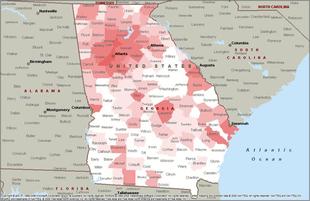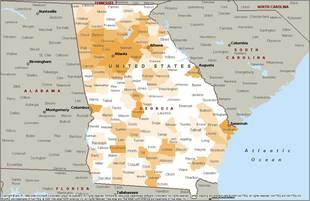Pandemic flu models help determine food distribution and school closing strategies
16 October 2008
The 1918 flu pandemic killed more than 40 million people worldwide and affected persons of all age groups. While it is difficult to predict when the next influenza pandemic will occur or how severe it will be, researchers at the Georgia Institute of Technology have developed models to help organisations such as emergency services and education authorities prepare emergency response plans.
"The models are flexible so that multiple scenarios can be investigated to see which options meet a certain goal," said Pinar Keskinocak, an associate professor in Georgia Tech's H Milton Stewart School of Industrial and Systems Engineering (ISyE). "This goal can be different for various groups, such as serving the most people given the availability of limited resources or minimizing the number of people infected while not negatively affecting businesses."
Details of the models, developed with ISyE associate professor Julie Swann and graduate student Ali Ekici, were presented last week at the US Institute for Operations Research and the Management Sciences Annual Meeting.
Knowing how many people will need food, how many food distribution facilities will be necessary, where the facilities should be located and how the resources should be allocated among the facilities is very important, according to Marilyn Self, who is the manager of disaster readiness for the Metropolitan Atlanta Chapter of the American Red Cross. Self has been collaborating with Georgia Tech researchers on this project.
"These models have provided solid food distribution data that has helped us formulate the questions we have to ask and the decisions that we have to make about food distribution during a pandemic on a local and statewide level," said Self.
The Georgia Department of Education is using Georgia Tech's models to investigate whether or not schools should be closed during a pandemic.
"Closing schools affects both families and businesses because parents will have to stay home and take care of children," said Garry McGiboney, associate state superintendent at the Georgia Department of Education. "We have to worry about important emergency workers like hospital staff members and law enforcement officers not being able to work because they have to tend to their children because schools are closed."
To estimate the number of meals required for a given area or determine if closing schools would be beneficial, the researchers first needed to determine how many people and/or households would be infected. To do this, they constructed a generic disease spread model, which described how the influenza disease would spread among individuals.
The researchers used US Census Bureau tract data — including household statistics, work flow data, classroom sizes and age statistics — to test the model. Crowded areas, including Atlanta and its suburbs, were always affected around the same time regardless of where the disease initiated. However, the time required for the disease to spread to rural areas depended on where the disease started.
With this information, the Georgia Tech researchers used the disease spread model as a forecasting tool to calculate the number of meals that would be required in metropolitan Atlanta during a flu pandemic. They tested three major scenarios: feeding every household with an infected individual (someone symptomatic or hospitalized), every household with an infected adult, or every household with all adults infected.
The simulations showed that the 15 counties surrounding Atlanta would require approximately 2.2 million, 1.4 million or 150,000 meals per day for the respective scenarios during the peak infection period. For the entire pandemic, the number of meals would reach 62, 38 or 3.8 million for the three scenarios respectively.
Simulation examples
 |
| This simulation result shows where active cases of the flu would be located 40 days after the start of a pandemic if the initial infection location was Fulton County, Georgia — the county where the city of Atlanta is located. |
 |
| This simulation result shows where active cases of the flu would be located 40 days after the start of a pandemic if the initial infection location was Atkinson County, Georgia — a rural county in southern Georgia. |
The researchers also determined the number of meals that would be necessary if only those households that fell below a certain income level were fed. The results showed that 200,000; 120,000 or 14,000 meals per day would be required for the respective scenarios during the peak infection period in that case.
Interventions such as voluntary quarantine or school closures could also affect food distribution by changing the number of infected individuals.
"Voluntary quarantine means that if an individual is sick in a household, everyone in that household should stay home," explained Keskinocak. "However, we realize that not everyone will follow this rule, so the model assumes that only a certain percentage of infected individuals will stay home."
The researchers investigated the effects of voluntary quarantine on disease spread, as well as the best time to begin the quarantine and how long it should last.
The results showed that the number of people infected at the peak time and the total number of individuals infected decreased as the length of the quarantine was extended, but there was a diminishing rate of return. The researchers determined that an eight-week quarantine was the most effective in terms of reducing the number of individuals infected during the peak time if it was implemented at the beginning of the fourth week.
"These results are important because during a pandemic, communities have limited resources, including food and volunteers to distribute the food," noted Swann. "If fewer people require the resources, especially during the peak time period, organizations like the American Red Cross can meet the needs of more people."
The researchers also compared the two interventions — quarantine and school closure. The results showed that closing schools reduced the number of people infected with the virus. However, a four-week voluntary quarantine was found to be at least as effective as a six-week school closure for reducing the percentage of the population infected with the virus and the number of people infected at the peak time.
The Georgia Department of Education and the Metropolitan Atlanta Chapter of the American Red Cross have used the models to gain insight into the best ways for their organizations to respond to a flu pandemic.
"Running all of these different scenarios has helped us realize that we will have a lot more people to feed in metropolitan Atlanta during a pandemic flu than we imagined. The models have provided us with a realistic idea of where we'll need to locate community food distribution facilities and how many we might need to have given certain assumptions and decisions," said Self.
The researchers plan to conduct future work in two areas – developing models for other states and extending the model to also include vaccine distribution. The model may also be useful for other purposes such as estimating hospital capacity needs, according to Keskinocak.
"While we hope that a pandemic never occurs, our models will help Georgia and other states across the United States prepare response plans for the potential," added Keskinocak.
Bookmark this page
Del.icio.us
Reddit
StumbleUpon